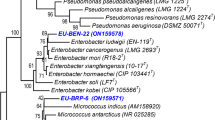Abstract
A study was conducted to determine whether colonization of legume roots and nodulation byRhizobium meliloti andBradyrhizobium japonicum could be enhanced by using inocula containing microorganisms that produce antibiotics suppressing soil or rhizosphere inhabitants but not the root-nodule bacteria. An antibiotic-producing strain of Pseudomonas and one of Bacillus were isolated, and mutants ofR. meliloti andB. japonicum sp. resistant to the antibiotics were used. The colonization of the alfalfa rhizosphere and nodulation byR. meliloti were enhanced by inoculation of soil withPseudomonas sp. in soil initially containing 2.7×105 R. meliloti per g. The colonization of soybean roots byB. japonicum was enhanced by inoculating soil with three cell densities ofBacillus sp., and nodulation was stimulated byBacillus sp. added at two cell densities. In some tests, the dry weights of soybeans and seed yield increased as a result of these treatments, and co-inoculation with Bacillus also increased pod formation. Inoculation of seeds withBacillus sp. and the root-nodule bacterium enhanced nodulation of soybeans and alfalfa, but colonization byB. japonicum andR. meliloti was stimulated only during the early period of plant growth.
Studies were also conducted withStreptomyces griseus and isolates ofR. meliloti andB. japonicum resistant to products of the actinomycete. Nodulation of alfalfa byR. meliloti was little or not affected by the actinomycete alone; however, both nodulation and colonization were enhanced if the soil was initially amended with chitin andS. griseus was also added. Chitin itself did not affectR. meliloti. Treatments of seeds with chitin orS. griseus alone did not enhance colonization of alfalfa roots byR. meliloti or soybean roots byB. japonicum, but the early colonization of the roots by both bacterial species was promoted if the seeds received both chitin andS. griseus; this treatment also increased nodulation and dry weights of alfalfa and soybeans and the N content of alfalfa. It is suggested that co-inoculation of legumes with antibiotic-producing microorganisms and root-nodule bacteria resistant to those antibiotics is a promising means of promoting nodulation and possibly nitrogen fixation.
Similar content being viewed by others
References
Alexander M 1985 Enhancing nitrogen fixation by use of pesticides: a review. Adv. Agron. 38, 267–282.
Amarger N 1981 Selection ofRhizobium strains on their competitive ability for nodulation. Soil Biol. Biochem. 13, 481–486.
Anderson K J 1957 The effect of soil micro-organisms on the plant-rhizobia association. Phyton (Rev. Int. Bot. Exp.) 8, 59–73.
Bohlool B B and Schmidt E L 1973 Persistence and competition aspects ofRhizobium japonicum observed in soil by immunofluorescence microscopy. Soil Sci. Soc. Am. Proc. 37, 561–564.
Filippi C, Bagnoli G, Volterrani M and Picci P 1987 Antagonistic effects of soil bacteria onFusarium oxysporum f. sp.dianthi (Prill and Del) Snyd. and Hans. Plant and Soil 98, 161–167.
Harris J R 1953 Influence of rhizosphere micro-organisms on the virulence ofRhizobium trifolii. Nature (London) 172, 507–508.
Hely F W, Bergerson F J and Brockwell J 1957 Microbial antagonism in the rhizosphere as a factor in the failure of inoculation of subterranean clover. Aust. J. Agric. Res. 8, 24–44.
Hodgson A L M, Roberts W P and Waid J S 1985 Regulated nodulation ofTrifolium subterraneum inoculated with bacteriocin-producing strains ofRhizobium trifolii. Soil Biol. Biochem. 17, 475–478.
Hossain A K M and Alexander M 1984a Enhancing soybean rhizosphere colonization byRhizobium japonicum. Appl. Environ. Microbiol. 48, 468–472.
Hossain A K M and Alexander M 1984b Enhancing growth and nitrogen uptake by soybeans using pesticides. Plant and Soil 81, 133–141.
Howell C R and Stipanovic R D 1979 Control ofRhizoctonia solani on cotton seedlings withPseudomonas fluorescens and with an antibiotic produced by the bacterium. Phytopathology 69, 480–482.
Li D-M and Alexander M 1986 Bacterial growth rates and competition affect nodulation and root colonization byRhizobium meliloti. Appl. Environ. Microbiol. 52, 807–811.
Limar T E, Polyanskaya L M, Kozhevin P A and Zvyagintsev D G 1984 Measures for increasing the numbers of nodule bacteria in soil (In Russian). Mikrobiologiya 53, 830–832.
Mitchell R and Alexander M 1962 Microbiological processes associated with the use of chitin for biological control. Soil Sci. Soc. Am. Proc. 26, 556–558.
Pena-Cabriales J J and Alexander M 1983 Growth of Rhizobium in soil amended with organic matter. Soil Sci. Soc. Am. J. 47, 241–245.
Plazinski J and Rolfe B G 1985 Influence of Azospirillum strains on the nodulation of clovers by Rhizobium strains. Appl. Environ. Microbiol. 49, 984–989.
Polyanskaya L M, Kozhevin P A and Zvyagintsev D G 1985 Stimulation and elimination of nodule bacteria in soil after the introduction of an actinomycete and chitin (In Russian). Mikrobiologiya 53, 1012–1015.
Author information
Authors and Affiliations
Rights and permissions
About this article
Cite this article
Li, DM., Alexander, M. Co-inoculation with antibiotic-producing bacteria to increase colonization and nodulation by rhizobia. Plant Soil 108, 211–219 (1988). https://doi.org/10.1007/BF02375651
Received:
Revised:
Issue Date:
DOI: https://doi.org/10.1007/BF02375651




